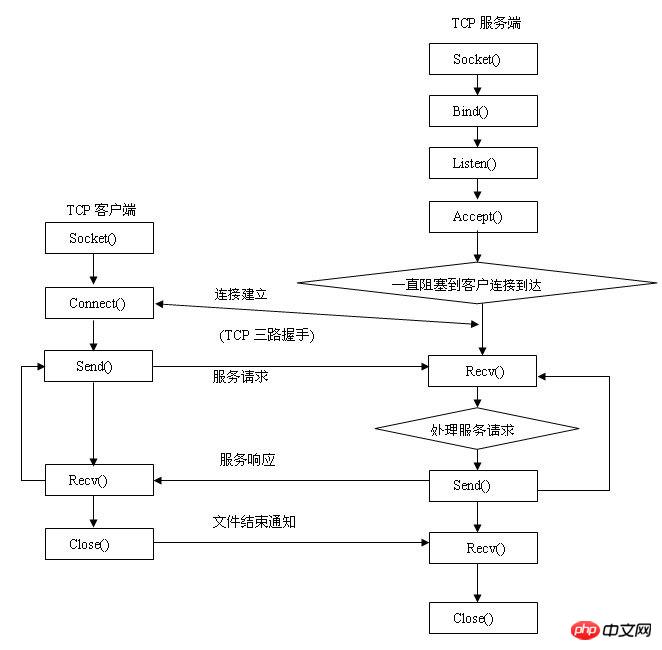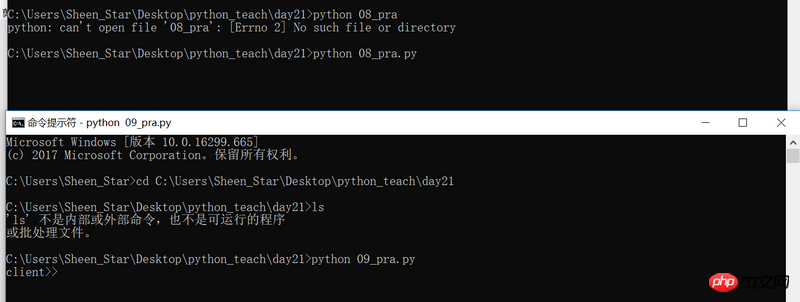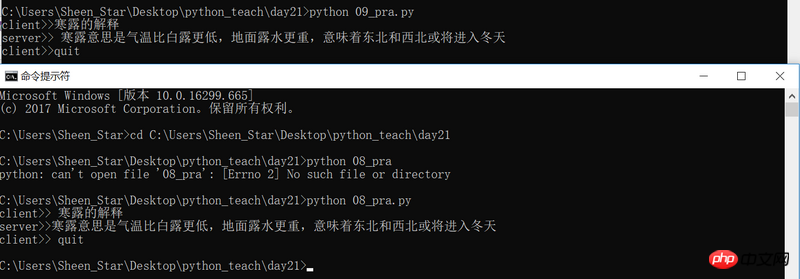 Backend Development
Backend Development
 Python Tutorial
Python Tutorial
 Introduction to socket implementation of TCP communication in python (with examples)
Introduction to socket implementation of TCP communication in python (with examples)
Introduction to socket implementation of TCP communication in python (with examples)
This article brings you an introduction to the implementation of TCP communication through sockets in Python (with examples). It has certain reference value. Friends in need can refer to it. I hope it will be useful to you. Helps.
TCP
TCP (Transmission Control Protocol) is a connection-oriented, reliable, byte stream-based transport layer communication protocol, developed by the IETF Definition of RFC 793. In the simplified OSI model of computer networks, it completes the functions specified by the fourth layer transport layer. User Datagram Protocol (UDP) is another important transport protocol within the same layer [1]. In the Internet protocol suite, the TCP layer is an intermediate layer located above the IP layer and below the application layer. Reliable, pipe-like connections are often required between application layers of different hosts, but the IP layer does not provide such a flow mechanism, but provides unreliable packet switching.
The following is a schematic diagram of socket realizing TCP communication. We write the program according to the schematic diagram

TCP server
The server process must first bind a port and listen for connections from other clients. If a client connects, the server establishes a Socket connection with the client, and subsequent communications rely on this Socket connection.
Let's write a simple server program that receives client connections and replies to requests from clients.
import socket
server = socket.socket()
server.bind(('192.168.1.165',8900))
#调用 listen() 方法开始监听端口, 传入的参数指定等待连接的最大数量
server.listen(4)
serObj,address = server.accept()
#当有客户端访问时,实现两边的交流,如果有一方退出,整个程序退出。
#服务器程序通过一个永久循环来接受来自客户端的连接
#这里虽然给出最大连接数为4,但单线程程序也只会响应一个连接
while True:
#建立连接后,服务端等待客户端发送的数据,实现通信
re_data = serObj.recv(1024).decode('utf-8')
print('client>>',re_data)
if re_data == 'quit':
break
send_data = input('server>>')
serObj.send(send_data.encode('utf-8'))
if send_data == 'quit':
break
serObj.close()
server.close()TCP Client
Most connections are reliable TCP connections. When a TCP connection is created, the one who initiates the connection is called the client, and the one who is
initiated to respond to the connection is called the server.
To actively initiate a TCP connection, the client must know the IP address and port number of the server.
import socket
client = socket.socket()
client.connect(('192.168.1.165',8900))
while True:
send_data = input("client>>")
client.send(send_data.encode('utf-8'))
if send_data == 'quit':
break
re_data = client.recv(1024).decode('utf-8')
if re_data == 'quit':
break
print("server>>",re_data)
client.close()Use one window to run the client and another window to run the server, so you can see the effect more intuitively.
Here my 08_pra.py is the server program and 09_pra.py is the client program
Schematic diagram when the connection is just established

One communication Completed diagram

The above is the detailed content of Introduction to socket implementation of TCP communication in python (with examples). For more information, please follow other related articles on the PHP Chinese website!

Hot AI Tools

Undresser.AI Undress
AI-powered app for creating realistic nude photos

AI Clothes Remover
Online AI tool for removing clothes from photos.

Undress AI Tool
Undress images for free

Clothoff.io
AI clothes remover

AI Hentai Generator
Generate AI Hentai for free.

Hot Article

Hot Tools

Notepad++7.3.1
Easy-to-use and free code editor

SublimeText3 Chinese version
Chinese version, very easy to use

Zend Studio 13.0.1
Powerful PHP integrated development environment

Dreamweaver CS6
Visual web development tools

SublimeText3 Mac version
God-level code editing software (SublimeText3)

Hot Topics
 1377
1377
 52
52
 Do mysql need to pay
Apr 08, 2025 pm 05:36 PM
Do mysql need to pay
Apr 08, 2025 pm 05:36 PM
MySQL has a free community version and a paid enterprise version. The community version can be used and modified for free, but the support is limited and is suitable for applications with low stability requirements and strong technical capabilities. The Enterprise Edition provides comprehensive commercial support for applications that require a stable, reliable, high-performance database and willing to pay for support. Factors considered when choosing a version include application criticality, budgeting, and technical skills. There is no perfect option, only the most suitable option, and you need to choose carefully according to the specific situation.
 How to use mysql after installation
Apr 08, 2025 am 11:48 AM
How to use mysql after installation
Apr 08, 2025 am 11:48 AM
The article introduces the operation of MySQL database. First, you need to install a MySQL client, such as MySQLWorkbench or command line client. 1. Use the mysql-uroot-p command to connect to the server and log in with the root account password; 2. Use CREATEDATABASE to create a database, and USE select a database; 3. Use CREATETABLE to create a table, define fields and data types; 4. Use INSERTINTO to insert data, query data, update data by UPDATE, and delete data by DELETE. Only by mastering these steps, learning to deal with common problems and optimizing database performance can you use MySQL efficiently.
 MySQL can't be installed after downloading
Apr 08, 2025 am 11:24 AM
MySQL can't be installed after downloading
Apr 08, 2025 am 11:24 AM
The main reasons for MySQL installation failure are: 1. Permission issues, you need to run as an administrator or use the sudo command; 2. Dependencies are missing, and you need to install relevant development packages; 3. Port conflicts, you need to close the program that occupies port 3306 or modify the configuration file; 4. The installation package is corrupt, you need to download and verify the integrity; 5. The environment variable is incorrectly configured, and the environment variables must be correctly configured according to the operating system. Solve these problems and carefully check each step to successfully install MySQL.
 MySQL download file is damaged and cannot be installed. Repair solution
Apr 08, 2025 am 11:21 AM
MySQL download file is damaged and cannot be installed. Repair solution
Apr 08, 2025 am 11:21 AM
MySQL download file is corrupt, what should I do? Alas, if you download MySQL, you can encounter file corruption. It’s really not easy these days! This article will talk about how to solve this problem so that everyone can avoid detours. After reading it, you can not only repair the damaged MySQL installation package, but also have a deeper understanding of the download and installation process to avoid getting stuck in the future. Let’s first talk about why downloading files is damaged. There are many reasons for this. Network problems are the culprit. Interruption in the download process and instability in the network may lead to file corruption. There is also the problem with the download source itself. The server file itself is broken, and of course it is also broken when you download it. In addition, excessive "passionate" scanning of some antivirus software may also cause file corruption. Diagnostic problem: Determine if the file is really corrupt
 How to optimize MySQL performance for high-load applications?
Apr 08, 2025 pm 06:03 PM
How to optimize MySQL performance for high-load applications?
Apr 08, 2025 pm 06:03 PM
MySQL database performance optimization guide In resource-intensive applications, MySQL database plays a crucial role and is responsible for managing massive transactions. However, as the scale of application expands, database performance bottlenecks often become a constraint. This article will explore a series of effective MySQL performance optimization strategies to ensure that your application remains efficient and responsive under high loads. We will combine actual cases to explain in-depth key technologies such as indexing, query optimization, database design and caching. 1. Database architecture design and optimized database architecture is the cornerstone of MySQL performance optimization. Here are some core principles: Selecting the right data type and selecting the smallest data type that meets the needs can not only save storage space, but also improve data processing speed.
 Does mysql need the internet
Apr 08, 2025 pm 02:18 PM
Does mysql need the internet
Apr 08, 2025 pm 02:18 PM
MySQL can run without network connections for basic data storage and management. However, network connection is required for interaction with other systems, remote access, or using advanced features such as replication and clustering. Additionally, security measures (such as firewalls), performance optimization (choose the right network connection), and data backup are critical to connecting to the Internet.
 Solutions to the service that cannot be started after MySQL installation
Apr 08, 2025 am 11:18 AM
Solutions to the service that cannot be started after MySQL installation
Apr 08, 2025 am 11:18 AM
MySQL refused to start? Don’t panic, let’s check it out! Many friends found that the service could not be started after installing MySQL, and they were so anxious! Don’t worry, this article will take you to deal with it calmly and find out the mastermind behind it! After reading it, you can not only solve this problem, but also improve your understanding of MySQL services and your ideas for troubleshooting problems, and become a more powerful database administrator! The MySQL service failed to start, and there are many reasons, ranging from simple configuration errors to complex system problems. Let’s start with the most common aspects. Basic knowledge: A brief description of the service startup process MySQL service startup. Simply put, the operating system loads MySQL-related files and then starts the MySQL daemon. This involves configuration
 How to optimize database performance after mysql installation
Apr 08, 2025 am 11:36 AM
How to optimize database performance after mysql installation
Apr 08, 2025 am 11:36 AM
MySQL performance optimization needs to start from three aspects: installation configuration, indexing and query optimization, monitoring and tuning. 1. After installation, you need to adjust the my.cnf file according to the server configuration, such as the innodb_buffer_pool_size parameter, and close query_cache_size; 2. Create a suitable index to avoid excessive indexes, and optimize query statements, such as using the EXPLAIN command to analyze the execution plan; 3. Use MySQL's own monitoring tool (SHOWPROCESSLIST, SHOWSTATUS) to monitor the database health, and regularly back up and organize the database. Only by continuously optimizing these steps can the performance of MySQL database be improved.



